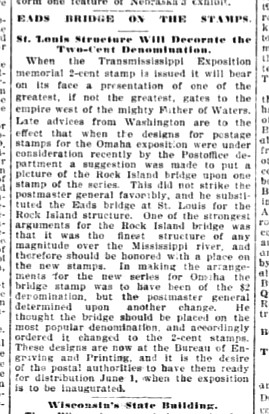The Bridge Debate
Prior to the final decision to include the Eads Bridge in St. Louis as the subject of the $2 Trans-Mississippi stamp, two other bridges were suggested. This page will strive to detail and clarify these suggestions.
On January 12, 1898, the Omaha World-Herald published the following announcement of stamp designs:

This listed the $2 stamp subject as “The Rock Island bridge”, showing part of the city of Omaha.
While the Trans-Mississippi Exposition was held to showcase the development of the West as a whole, most of the focus was on the host city. Many of the exposition leaders were from Nebraska – the most notable of these leaders being publicity manager Edward Rosewater, who was closely involved in the development of the Trans-Mississippi stamps.
This article makes it clear that the suggested bridge was located in Omaha. Although it does not currently go by the name “Rock Island Bridge”, one can assume the bridge suggested is the Union Pacific Bridge over the Missouri River. (The Union Pacific Railroad connected with the Rock Island Railroad in Omaha, and would eventually merge with the company.) This bridge is significant to the West in that it connected the first transcontinental railroad.
Twelve days later, an article is published by Omaha Daily Bee that announces the Eads Bridge in St. Louis was selected over the Rock Island Bridge.

This article mentions that the Rock Island Bridge was selected because it was “the finest structure of any magnitude over the Mississippi River.” At this point, the bridge suggested is not the Union Pacific Bridge in Omaha (which spans the Missouri River). Instead this article suggests that the “Rock Island Bridge” in question was the Government Bridge, which connected Rock Island, Illinois and Davenport, Iowa over the Mississippi River.
The Post Office department believed that a Mississippi River crossing point was an important inclusion for the series.
It is stated in this article that the bridge was first suggested for the $2, but that Postmaster General Gary decided it should go on the 2¢ stamp.
Four months later, on May 17, 1898, the Omaha Daily Bee published an article announcing the final selection of subjects for the stamps. At the end of this announcement was the following article:

This article mentions that “Mr. Gray insisted upon instead of the St. Louis bridge, but as the former was neither picturesque nor costly, and the small town of Davenport would have been portrayed as a leading western city, Mr. Gray was ruled down. Mr. Gray also insisted upon having the St. Louis bridge upon the two-cent stamp instead of at the end of the series, where it properly belongs.”
From this we can confirm that the Government Bridge was one of the “Rock Island” bridges suggested.
This article also raises several questions: Who is Mr. Gray? Most likely this is referring to Postmaster General Gary, called “Gray” here by mistake. It is unusual, however, that he would be titled “Mr.” rather than “Postmaster”.
If Mr. Gray is, in fact, Postmaster Gary, then this article contradicts the earlier January 24th article. In the first article, Gary supported changing the value to 2¢; in the second article he supported changing the value to $2.
Conclusions:- The Union Pacific Bridge (Omaha, Nebraska) was a suggested bridge. It was probably included in the first list of subjects due to the influence of the exposition leaders hoping to promote the city of Omaha.
- The Government Bridge (Davenport, Iowa) was another suggested bridge. It was considered over the Union Pacific Bridge because it spanned the Mississippi River.
- The Eads Bridge (St. Louis, Missouri) was finally selected as the stamp subject. It is uncertain whether its originally intended value was 2¢ or $2, but it was eventually printed as the $2 value.